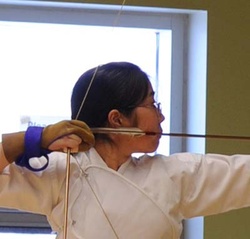When Mie Takahashi arrived in Toronto in July 2007 to study English, the 5th dan kyudoka searched for a place in the city to continue practicing kyudo. She eventually contacted the Kyudo Association of Canada (KAC), based in Vancouver, B.C., and they put her in contact with a woman in Toronto who was interested in learning kyudo. This was the beginning of a chain of events that brought kyudo to the Japanese Canadian Cultural Centre (JCCC).
Two packed kyudo workshops led by Mie Takahashi at the JCCC in the summer of 2008 demonstrated that there was a demand for kyudo and paved the way for regular kyudo classes to be held at the JCCC. Shortly after the second workshop the KAC put 5th dan Salvatore Gianfreda from Switzerland in touch with Mie Takahashi. Just months after the workshops, in November, 2008, the first beginners’ kyudo class of 20 students began led by two 5th dan instructors.
This first beginner’s session started with minimal equipment: enough gomu-yumi, practice “bows” for each student, some old straw tatami mats for targets and three bows from a previous kyudo class held over 10 years ago. More bows were eventually purchased, but the practice of kyudo involves much more than just individual target shooting. Taihai involves five archers entering the dojo, approaching the target and preparing for shooting in harmony, with precise timing and rhythm. At least five targets are necessary to practice taihai. In addition, the standard shooting distance for kyudo is 28 meters - a distance too great for the regular dojo. For a student to have any hope of passing a ranking exam, taihai experience and practice at the 28m (kinteki) distance are crucial.
We were able to achieve both of these important elements with the generous cooperation of JCCC. The club now has 12 targets, and we are in regular contact with the JCCC to arrange times for kinteki shooting in the parking area behind the dojo in nice weather. We would like to thank George Tsushima and Mas Yamashita, who constructed our first set of five stands to hold “makiwara” targets. As a result, we were able to host two successful seminars and invite Carly Born-sensei from the American Kyudo Renmei. Moreover, due to the relentless devotion of the instructor, Mie Takahashi, sixteen members passed their ranking examinations this summer in Minnesota.
We are also grateful for guidance provided by several volunteer assistant instructors who have joined us, mostly visitors from Japan and from various walks of life. When one of our original instructors, Salvatore Gianfreda left for Australia in early 2010, Mie Takahashi actively searched for volunteer kyudo instructors who could share their knowledge while practising English. Although many volunteer instructors have come and gone over the years we are also blessed with long-term additions to the group, such as Yukiko Itokawa, 3rd dan. These assistants have greatly increased the amount of individual attention that each student receives and has truly benefitted our development in kyudo. It has also been a great opportunity to promote friendship through culture, one of the key aims of the JCCC.
Several students in the class took the initiative of starting the Seikyu-kai (正弓会; literally translates to “truthful bow” but the meaning embodies truthfulness, correctness and honesty in life) with the goal of organizing the kyudo class to assist Mie Takahashi with various tasks necessary to help the group continue to advance. These tasks include organizing seminars, communicating with the JCCC and spreading kyudo within the community. We continue to develop an identity as a group within JCCC by creating a new logo, t-shirt and official website.
Our group has become large enough that with the cooperation of its dedicated members, equipment set-up and clean-up can be accomplished independently. As each new beginner class has joined the regular group, its members have implemented creative solutions to maximize shooting while keeping safety in mind. The future of our club will depend on our ability to integrate new students in our limited space. We look forward to this challenge.
We are very fortunate to be a part of the strong martial arts program at the JCCC. Through the support of the JCCC we have become the largest kyudo club in Canada. With a growing class of more than 30 students committed to their own development in kyudo and spreading kyudo to others, we believe that kyudo has truly taken root at the JCCC. We look forward to working together with the JCCC to continue learning and sharing Japanese culture in the city of Toronto and beyond.
* This articls was originally published in Japanese Canadian Cultural Centre's newsletter (December 2011/ January 2012, Vol.38 Issue 1).
© 2012 Haruka Chiba



